
[Photo: Courtesy of Endura Grease Management]
There is a lot to disagree about in life. But there is universal consensus on at least one point: used fats, oils, and grease—or FOG—should not foul our world. No one wants these remnants of food service in our sewers or waterways, backing up into our drains, or spilling out onto the landscape.
But FOG has to go somewhere. And it has post-food service uses, like upcycling into soaps, cosmetics, animal feed, or even textiles. The trick is to intercept it from the waste stream, preferably at the point of origin—restaurants, food processing facilities, prisons, and hospitals, among other locations—in a sanitary and affordable way. In excess, FOG builds up in sewer lines, restricts flow, and is capable of blockages that spill raw sewerage into homes, businesses, streets, and waterways.
To be clear, there are two types of FOG: “yellow” grease from deep fryers that is saved manually, and “brown” from dishwashers and floors, that is sent down drains where it could wreak havoc.
Fortunately, industries exist to combat this challenge. Liquid waste haulers, or “pumpers,” are companies that haul away FOG for recycling or to dump into sanitary landfills, which can ultimately create usable methane. But before that step, different types of interceptor devices have to capture FOG, as per local codes and ordinances of most municipalities.
“FOG interceptors have been in use since World War 1,” says Faith Winter, a market development specialist for the Endura line of Grease Management Technologies. “They would reuse the grease for lubricating moving parts on tanks and in the manufacturing of guns.” The urgency around FOG interception today, she explains, comes from the municipalities that are tightening codes for environmental reasons.

[Photo: Courtesy of Endura Grease Management]
Slow the Flow
Endura Grease Management Technologies somewhat upend the traditional interceptors used widely over the past 100 years. Officially known as “hydromechanical grease interceptors,” or HGIs, they are more sophisticated than “gravity grease interceptors,” or GGIs, the traditional model. The GGIs are more or less large tanks that serve as a reservoir for the passive separation of FOG from wastewater—a process that usually takes in excess of 20 minutes.
Most GGIs are made of concrete or metal: Both materials are subject to corrosion, leaks, and foul odors, with operational lives of as little as three years. Endura instead is made of an engineered thermoplastic material that is resilient to such corrosion. The plastic (and all accompanying mechanisms) can last up to 10-plus years.
The Endura interceptors also have an innovative flow-control baffling device. This slows the flow of dirty water from the source, which enables better separations of FOG, water, and solid particles—in other words, no fast flushes at rush hour that would enable those components to stay together. Instead, kitchen FOGs float on top of water (because they are less dense and therefore lighter in weight), cleaner water continues flowing to the municipal sewer system, and solids (food particles and such), drop to the bottom of the interceptors. Aiding the slower flow is an air intake vent that effectively mixes air and grease molecules, increasing its floatation properties.
Credit the Endura research and development team for devising the systems and achieving its net effects. “This interceptor produces less toxic waste and damage to downstream city infrastructure,” says Rob Cooke, director of innovations. “They also demand less water to function.”

Before
[Photo: Courtesy of Endura Grease Management]

After
Easy Clean, More Green
All interceptors need periodic cleaning, and the Endura products are no exception. The difference is the HGI model is greener and more efficient. The pumpers make their money by hauling away the contents of the interceptor, which is predominantly FOG, using less fuel if there is less water in the haul.
The Endura tanks also tend to be smaller (they come in various sizes) and consequently require more frequent cleanings. “This came from rethinking the entire process,” says Cooke. “Smaller tanks are easier to install and maintain, and because the engineered thermoplastic material has smooth walls, it’s extremely difficult for grease and bacteria to cling to it.” For the food service operator, however, the first priority lies in having a clean, lower-cost operation.
Health and sanitation authorities in many jurisdictions closely monitor those maintenance schedules. Winter says code enforcement varies by location, but the cleaning schedule manifest is part of periodic inspections. She says particularly in drought-prone California and similar locales where water savings matter most, the Endura product finds its warmest reception.
But the matter of FOG interceptors remains front and center for all concerned. “We’re able to capture 98% of grease,” says Winter. And Cooke’s team aims to improve even that.
Endura is a registered trademark.

[Photo: Courtesy of Endura Grease Management]
As Seen In
You’ll also find Endura’s work at:
- Ruth’s Chris
- Steak House
- Cookie It Up
Learn more about Endura Grease Management and see related content about drainage systems.

